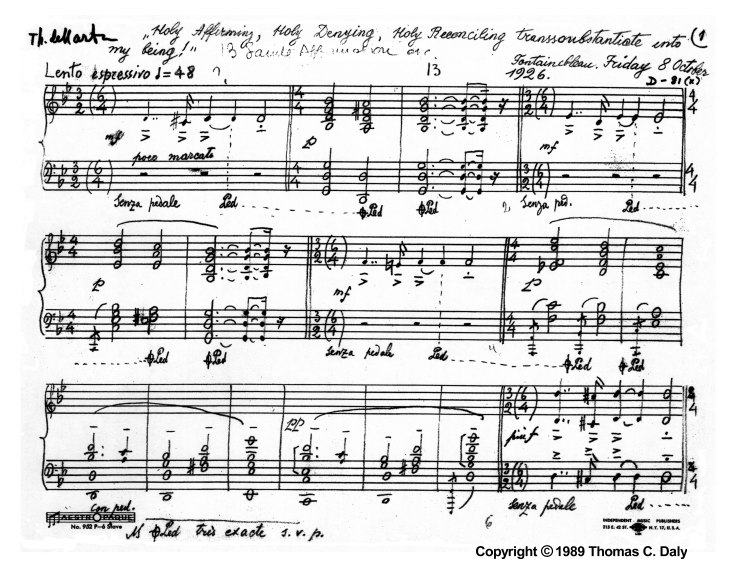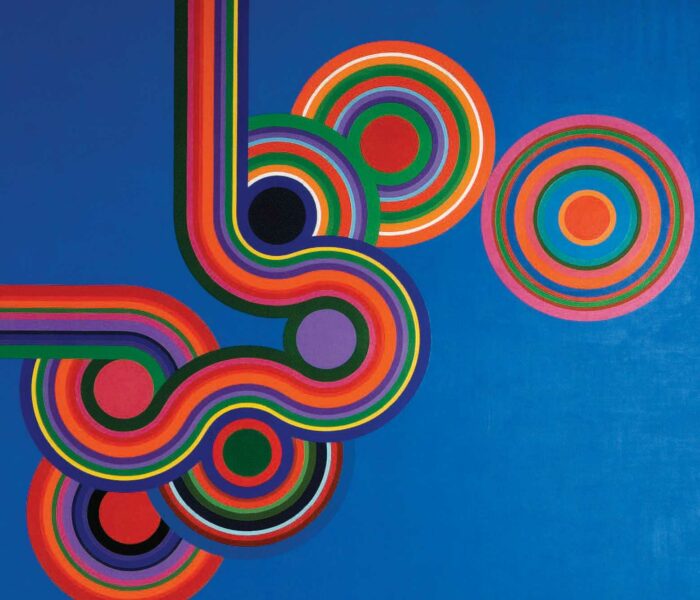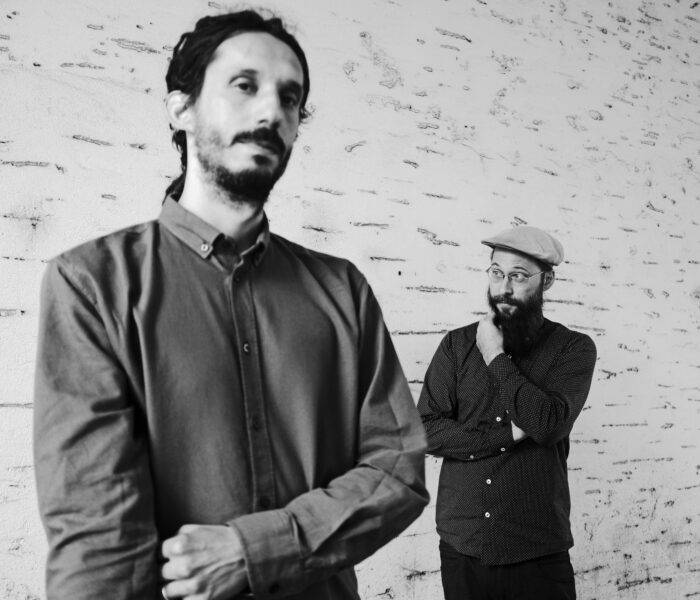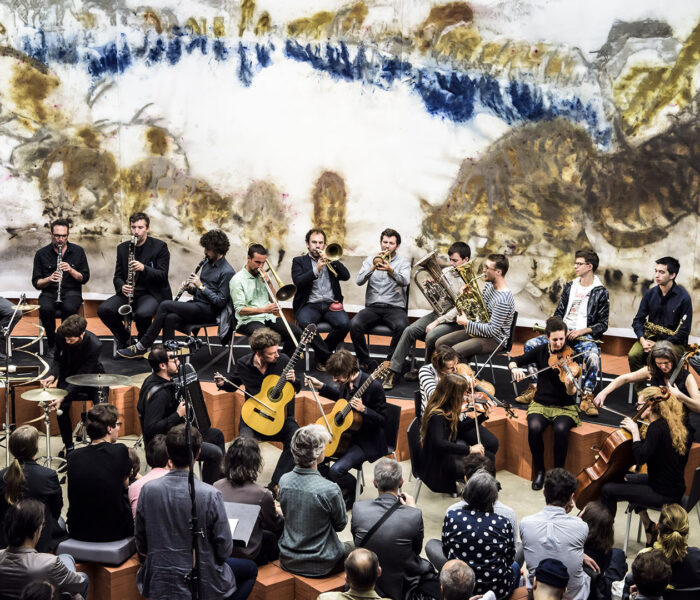Une mélodie, une harmonie ou un rythme (ou les trois ensemble) peuvent nous toucher au point d’avoir la tentation en retour de toucher la musique elle-même : en la jouant sur un instrument ou en la chantant. Mais comment toucher la musique, par définition impalpable ? La transcription s’est donnée cette mission : fixer pour mieux partager. De l’oral à l’écrit et vice-versa, transcrire, c’est redonner à vivre.
« À la fin de notre première rencontre, j’avais appris qu’il n’y aurait pas de partition. […] Mon travail consisterait à noter toutes les parties instrumentales pour le petit ensemble de musiciens français, qui attendraient les partitions. Mes premiers contacts avec la musique classique indienne étaient récents et peu encourageants. J’avais écouté un disque de Ravi [Shankar] enregistré en concert et n’y avais rien compris. Au lieu de paniquer, je lui ai demandé – « supplié » serait plus juste – de commencer le travail de composition en avance. […] Je n’ai pas réalisé sur le coup l’impact que cet apprentissage aurait sur ma musique. À cet instant, dans ce studio d’enregistrement des Champs-Élysées, je possédais enfin les outils conceptuels nécessaires à l’accomplissement de mon travail. »(1)
En 1966, Ravi Shankar tient le rôle-titre du film Chappaqua de Conrad Rooks. La musique d’Ornette Coleman ayant été refusée par le réalisateur, ce dernier demande à Shankar de prendre sa place en se faisant aider d’un élève de Nadia Boulanger : Philip Glass. La tâche est plus que complexe pour le jeune compositeur de passage dans la capitale pour ses études. Il est peu habitué à la musique indienne, où l’improvisation, bien qu’extrêmement cadrée, est de rigueur. Bon gré mal gré il s’en sort – non sans angoisse – et son langage musical en restera toute sa vie marqué. Il retrouvera Shankar des années plus tard (en 1990) pour enregistrer l’un de ses plus grands disques, Passages où le croisement entre musique écrite et non écrite donne des merveilles d’intelligence musicale.
Pourquoi transcrire
À l’écoute de cet album classé – faute de mieux – dans les bacs « musique du monde », on peut se demander où débute l’improvisation et où la notation précise s’arrête. L’œuvre a été créée pour la première fois dans l’Hexagone en 2019, à la Philharmonie de Paris, par des musiciens qui n’avaient pas participé à l’enregistrement. Pour ce faire, il a donc fallu créer pour eux une partition, et donc réaliser une transcription. Dans la musique occidentale classique (et donc dans la musique contemporaine), la notation a toujours eu une certaine forme de « supériorité » sur l’improvisation. S’ouvrir les portes des grandes salles de concert, obtenir des prix honorifiques en tout genre ainsi que la reconnaissance de ses pairs nécessite de mettre sa musique sur papier afin qu’elle soit lue, jouée, jugée et entendue. Laisser à un musicien la liberté d’improviser sans avoir passé des heures penché sur une partition ne donne pas l’image d’une vision musicale sérieuse.
Pour preuve, le mépris longtemps affiché de certains compositeurs contemporains envers le jazz, musique improvisée par essence. Le paradoxe étant que le jazz est certainement de nos jours la musique improvisée la plus transcrite… car cette musique s’est institutionnalisée et s’enseigne désormais dans les grandes écoles. Transcrire et jouer un solo de John Coltrane (Giant Steps of course!), de Miles Davis ou d’Oscar Peterson fait ainsi partie de l’apprentissage. C’est d’ailleurs devenu un défi sur Youtube, pour certains geeks musicaux, de noter au mieux ces solos improvisés à la note près, comme le montre cette splendide improvisation de Jacob Collier retranscrite précisément – jusqu’aux tâtonnements même de la main gauche…
L’écart entre l’écrit et le non-écrit n’a eu de cesse de se distendre au fur et à mesure que la notation s’est faite de plus en plus précise et détaillée. Dans l’histoire de la musique, le compositeur était bien souvent le propre interprète de sa musique (Bach, Mozart, Beethoven, Liszt, Rachmaninov), mais ces deux métiers ont eu tendance, de plus en plus, à se distinguer. Liszt improvisait beaucoup quand il jouait ses œuvres (ainsi que celles des autres). Aujourd’hui, improviser dans Liszt, Chopin ou même Boulez serait inenvisageable – voire sacrilège. L’interprète doit s’en tenir à une fidélité absolue – brandie comme une vertu. À l’époque baroque, une basse chiffrée et une mélodie pouvaient suffire à faire œuvre, les compositeurs faisaient confiance à leurs interprètes. Plus on s’approche de notre temps, plus les partitions fourmillent de détails, laissant de moins en moins de liberté aux musiciens. Parfois ces partitions sont tellement saturées d’indications que seul un ordinateur peut répondre à cette exigence d’exactitude.
Le plaisir de jouer
Les musiciens issus du jazz, des musiques électroacoustiques, alternatives et expérimentales ont su conserver une certaine liberté : pas de notation ou très peu, juste un canevas ou une grille. Mais la contrepartie est chère : sans notation, impossible pour d’autres de reproduire leurs œuvres. Pourtant, transcrire une pièce musicale improvisée afin qu’un autre musicien se l’approprie est une pratique passée et de plus en plus utilisée grâce aux logiciels de composition.
L’exemple type est le Köln Concert de Keith Jarrett. Selon le pianiste, « l’improvisation est le seul moyen d’être présent et fidèle à soi-même ». Aussi ce concert improvisé devenu cultissime a rapidement été transcrit afin de contenter les fans musiciens désireux de mettre les doigts sur cette musique légendaire née spontanément en Allemagne en 1975. La lecture de la partition (validée par Jarrett lui-même) nous montre à quel point, s’agissant d’une telle musique, la notation s’avère limitée. Tout le vocabulaire musical est insuffisant pour exprimer le côté « hors du temps » de cette musique. Aussi, l’écoute en continu de ce concert (conseillée par le musicien lui-même) semble indispensable afin de mieux l’approcher. Éditer une improvisation n’est pas anodin pour un musicien. C’est figer ce qui, au départ, ne devait pas l’être, et en même temps insuffler à son « œuvre » (c’est-à-dire en l’occurrence : à son disque) une deuxième vie grâce à une nouvelle interprétation.
Ceux qui l’ont entendu le confirment : les improvisations du compositeur français Déodat de Séverac, régionaliste convaincu qui s’intéressait de près au folklore français du Sud-Ouest, dépassaient de loin toutes ses œuvres écrites. La spontanéité, la liberté et l’énergie du moment qu’offre l’improvisation lui permettaient certainement de s’épanouir et de s’éloigner de la rigidité de l’écriture. Ainsi ses plus belles œuvres restèrent-elles non écrites.
Le Hongrois Béla Bartok, l’Arménien Komitas ou l’Australien Percy Grainger firent de même en allant puiser leur inspiration dans les musiques populaires de transmission orale. Ces artistes ont fait un travail précieux de recueil et de transcription d’airs folkloriques – bien souvent méprisés par l’académisme – en les enregistrant telles des archives sonores et en les intégrant à leurs compositions originales et
Tout un pan de l’art musical voué à ne se transmettre qu’à l’oral devient ainsi accessible à tous ceux qui lisent la musique. Le non-écrit fixé se popularise plus vite et accède à une forme de légitimité, une reconnaissance institutionnelle. Il permet également, dans le cas de Komitas, de faire entendre la voix des plus pauvres, des opprimés et des oubliés, comme dans cette chanson populaire de 1905 relatant les massacres arméniens recueillie et sublimée par le compositeur.
Du son à l’écrit
Les librairies musicales ferment les unes après les autres. Mais quelle est la cause exacte de la disparition quasi totale des magasins de partitions en France ? Si acheter un roman auprès de sa librairie de quartier plutôt que sur Amazon est un geste bien vu, intelligent et éco-responsable ; télécharger gratuitement sur IMSLP (International Music Score Library Project – médiathèque en ligne de plus de 432 763 partitions libres de droit) ou commander sur internet une partition est devenu un réflexe bien malheureux, mais trop répandu chez les amateurs de musique (ainsi que chez les professionnels).
Voici un début d’explication à la raréfaction des librairies musicales. Mais ça n’est pas la seule. La notation de la musique a nettement diminué à partir de la seconde moitié du XX° avec l’apparition de l’enregistrement. On peut être un musicien reconnu, un groupe de pop-music célèbre sans jamais avoir tenu un crayon pointé sur une portée (ou utilisé un ordinateur). C’est d’ailleurs la possibilité de conserver une performance musicale sans l’écrire qui a permis l’extrême popularisation extrême de la musique, devenue un secteur économique plus que rentable.
La capacité d’enregistrer a donc rebattu totalement les cartes dans le monde des musiciens. Il est désormais possible de jouer et de propager sa musique sans savoir lire une clé de sol, simplement en la jouant et en l’enregistrant. Le complexe de la lecture solfégique dépassé, l’amateur aux doigts qui le démangent peut enfin partager sa musique.
Les musiques de Harold Budd, de Brian Eno ou de William Basinski (pour ne citer que les trois papes de la musique ambient) existent par l’enregistrement et se popularisent telles quelles.
Toutefois on peut remarquer ces dernières années une recrudescence de concerts où ces œuvres purement phonographiques, qui n’ont jamais éditées, sont jouées sur scène. Ainsi Music for Airports d’Eno a été transcrit par Didier Aschour pour son ensemble Dédalus ; Apollo: Atmospheres and Soundtracks, du même compositeur, a été interprété au festival Ars Musica, à Bruxelles, le 19 novembre 2022, par l’ensemble Sturm und Klang ; The Disintegration Loops de William Basinski est à l’affiche au Lieu unique le 25 novembre 2022 dans une version live avec orchestre.
Le paradoxe de cette musique non notée qui par son succès le devient (notée) met en évidence que : 1/ la musique live n’est pas morte comme parfois on le prétend (même si la pandémie récente n’a pas aidé à contrer cette opinion) ; 2/ transcrire une œuvre musicale non écrite reste le meilleur moyen de la rendre vivante.
Mission possible
Tant qu’il y aura de la musique composée, il y aura des musiciens pour la jouer.
Peu importe sa façon d’être composée, il nous faudra trouver un moyen pour l’apprendre. Pour le moment, la notation musicale solfégique reste la façon la plus simple et universelle (et compliquée en même temps). Des alternatives existent : sur YouTube fleurissent un nombre incalculable de tutoriels de piano, violon et autres expliquant visuellement – en s’inspirant du jeu vidéo Dance Dance Revolution (jeu vidéo culte japonais de danse avec les pieds) – comment placer ses doigts aux bons moments sur l’instrument ; sauf que cette méthode évacue tout ce qui fait le sel de la musique (nuances, articulations, phrasés, etc.) et ne s’intéresse qu’à l’aspect technique et sportif d’une exécution.
La transmission orale par imitation est également une solution très utilisée, mais elle exclut le plaisir solitaire de l’apprentissage et empêche de facto d’aborder des œuvres d’une grande complexité polyphonique.
La solution reste donc la transcription. La fidélité la plus rigoureuse étant le grand défi de cette pratique.
Voici quelques exemples de transcriptions particulières.
Giacinto Scelsi n’écrivait pas sa musique. Il improvisait au piano et un transcripteur (le plus plus connu fut Vieri Tosatti) réécrivait le tout sur une partition. Ensuite il s’isolait et à la suite d’échanges avec Scelsi sur des questions de nuances, orchestrations etc., notait précisément la musique : il « composait du Scelsi ». Sans ce transcripteur, qui jouerait Scelsi ?
Georges Gurdjieff et son ami, le compositeur ukrainien Thomas de Hartmann, à Paris, ont composé en collaboration des pièces d’une sidérante beauté d’une manière tout à fait originale : Gurdjieff, au coin du feu, sifflait, chantait, murmurait des mélodies capturées lors de ses voyages de jeunesse en Orient et en Asie pour que Hartmann les note au piano. Le tout a donné un recueil de plus de 160 pièces d’un folklore imaginé ou réel.
Le compositeur mexicain Conlon Nancarrow voulait se passer des limites techniques des interprètes et bien avant l’invention des ordinateurs, il s’est mis à composer directement pour piano mécanique à rouleaux (seuls instruments capables de jouer autant de notes avec une précision rythmique diabolique). Ainsi sa façon de transcrire la musique passait-elle non par le solfège, mais simplement en perçant ces fameux rouleaux à la main. Thomas Adès fera le chemin inverse en transcrivant pour deux pianos quelques-unes de ses fameuses Études transcendantes.



Partitions de Gurdjieff – Nancarrow – Lauten
Elodie Lauten, compositrice française formée auprès de la Monte Young, amie de Terry Riley, très injustement négligée en France, était une pianiste virtuose aux oeuvres pour piano bien souvent improvisées par elle-même. Kyle Gann, mémoire vivante de la musique minimaliste des années 1970 à aujourd’hui, a passé énormément de temps à transcrire quelques uns de ses opus fulgurants (Cat Counterpoint, Adamantine Sonata, Sonate Ordinaire, Sonate Modale, Variations on the Orange Cycle) afin de comprendre sa façon de composer.
Il s’en explique : « Bien qu’elle ait composé de nombreuses œuvres d’ensemble en notation conventionnelle, l’improvisation était pour elle une manière confortable de composer et elle considérait qu’une pièce était terminée après l’avoir jouée – la notation n’étant pas nécessaire. Ses pièces évoluaient au fur et à mesure qu’elle les jouait, gagnant ou perdant des sections. Comme La Monte Young, qui fut brièvement son mentor, elle conçoit des relations mélodiques et harmoniques qui ont une identité reconnaissable mais qui peuvent être improvisées selon des motifs extensibles. Ce sont des œuvres très importantes et très belles, et j’espère qu’il sera possible de leur assurer une place permanente dans le répertoire historique. »(2)
Après avoir passé des heures à mettre sur le papier The Well-Tuned Piano de La Monte Young et dévoilé au monde le chef-d’œuvre qu’est November de Dennis Johnson (1959), Kyle Gann poursuit son entreprise, incroyablement fidèle, de transcription, afin que les interprètes d’aujourd’hui puissent à leur tour s’approprier ces œuvres non écrites, ces ineffables compositions spontanées.
François Mardirossian
(1) Philip Glass, Paroles sans musique, Philharmonie De Paris, 2017.
(2) Kyle Gann, Elodie Lauten as Postminimalist Improviser – Delivered to the Minimalism Conference in Helsinki, September 2015 – https://www.kylegann.com/Lauten-Postminimalist.html



)



